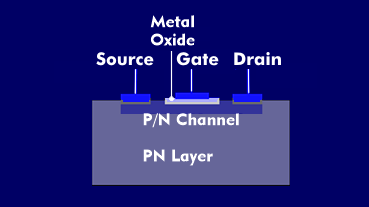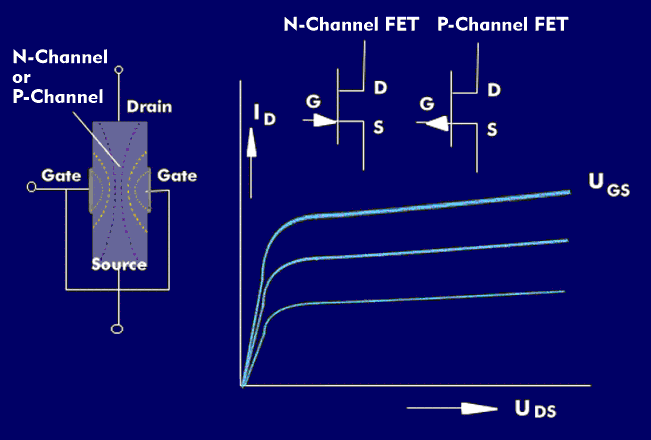field effect transistor (FET)
The field-effect transistor (FET) was developed as early as 1947 by the American physicists Bardeen and Shockley. Field-effect transistors differ significantly from bipolar transistors. Their three electrodes are called source, drain and gate. The source is the source for the charge carriers and corresponds to the emitter of a transistor, the drain is the drain electrode and corresponds to the collector, and the gate is the control electrode and corresponds to the base.
Field effect transistors control the current flow between the source (S) and the drain (D) with the electric field generated by the gate (G). This field allows the gate to establish a conductive channel between the source and drain. A small change in gate voltage has a large effect on the current flow between source and drain. That is why FETs can amplify signals with a relatively low signal level. The conductive channel can be an N or P channel.
When a gate voltage is applied, the electric field propagates into the channel depending on the polarity and the magnitude of the control voltage, affecting the size of the channel and thus the current flow. This is also referred to as the junction or space charge region.
At a gate voltage of 0 V, the maximum current flows and the channel is at its widest. With an N-channel, the gate voltage is negative and reduces the current flow with increasing potential until no current flows.
A distinction is made between Junction Field-Effect Transistors( JFET), which has a blocking junction between the gate and the source-drain channel, and the Isolated Gate FET( IGFET), which has an insulating layer between the gate and the source-drain channel. Since this is manufactured using MOS technology, it is referred to as a MOSFET. In this technology, the gate is electrically connected via an insulator, namely a metal oxide layer, and has an extremely high impedance. Thus, no current flows through the gate, and control is powerless. In addition to these technologies, there are also organic field-effect transistors( OFET), which are made of polymers, and the ferroelectric FeFET, which is suitable for memory cells.
With the FinFET and the MuGFET (multiple gate FET), there are variants with multiple gates that enclose the charge carrier channel, which require less energy, can be implemented smaller and have much shorter switching times. They are suitable for microprocessors and SRAMs.


